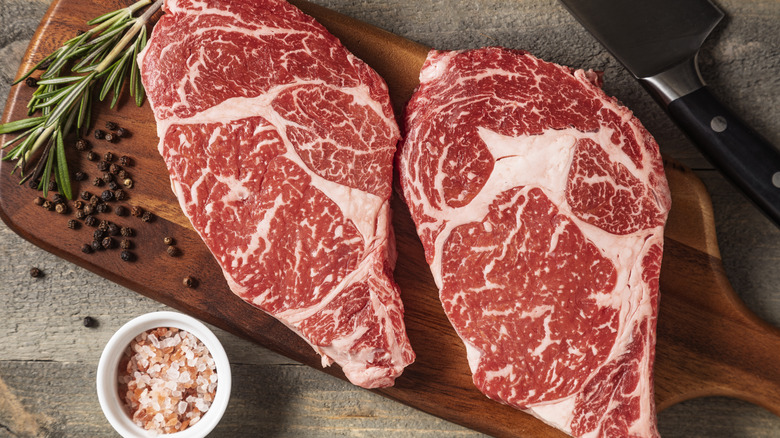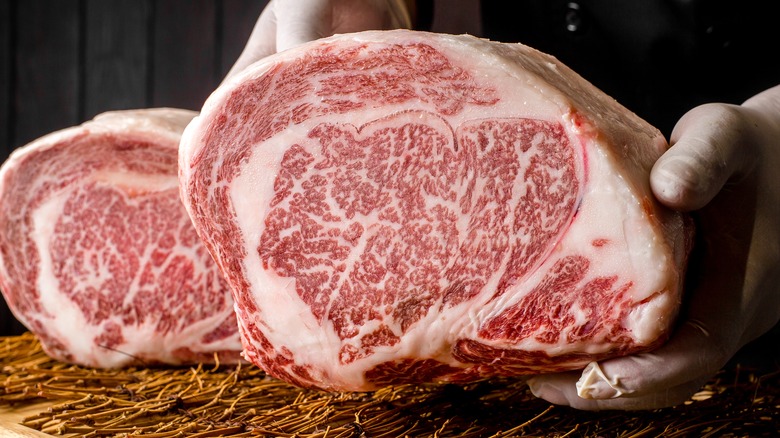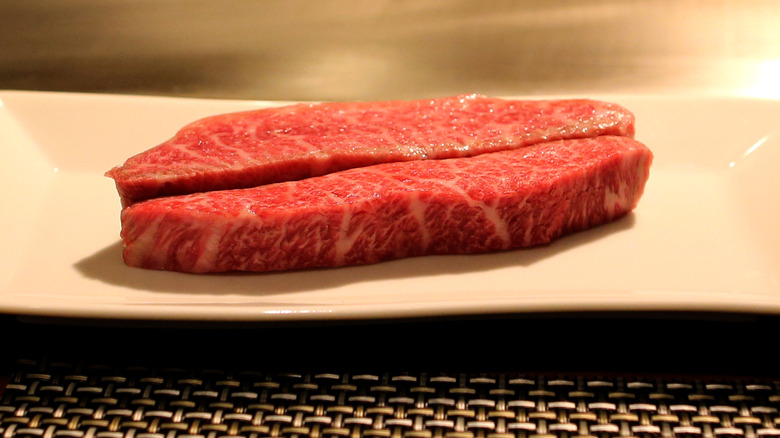Wagyu Vs Kobe Beef: What's The Difference?
Perusing any steakhouse menu can be confusing enough. First, you need to consider the various cuts of beef — strip versus tenderloin, T-bone versus porterhouse, filet mignon versus ribeye. Then you're confronted with whether or not the meat has been aged and, if so, whether a wet or dry technique has been used. Once you've sorted all that out and are lucky enough to be dining at a top-tier steakhouse, you could also be confronted with words like wagyu and Kobe — terms that aren't about the steak, per se, but more about the cattle from which it originated. Golan Haiem, founder and CEO of Destination Wagyu — an online meat delivery company that specializes exclusively in wagyu beef from Japan, Australia, and the United States — helped clarify things exclusively for Food Republic.
"Wagyu on its own just means Japanese cattle," Haiem explains. "It can refer to different breeds." The cattle are known to have a significant amount of marbling — the white streaks of fat you see in steak — and have a distinct buttery taste and texture. Kobe, however, is a type of wagyu that has to meet very specific criteria to be labeled as such. But the names do a lot more than tell you the type of cattle — they can also help you understand the flavors and textures you should expect when the meat arrives on your plate.
What is wagyu?
In Japan, wagyu cattle are raised in a strictly regulated environment on a prescribed diet of vitamins, minerals, grass, and high-energy grains. The beef from these cattle is meticulously graded, and Japanese A5 wagyu, representing the height of luxury, has the most exceptional levels of marbling, resulting in rich, buttery steaks. But, as Golan Haiem points out, "a lot of what you see outside Japan is crossbred or domestic wagyu." In fact, all of the wagyu outside of Japan is descended from 183 cattle that were exported throughout the world before 1997, the year the Japanese government declared the animals a national treasure and prohibited their export.
American wagyu, which is descended from those 183 cattle, has a more moderate level of marbling, similar to that of USDA Prime beef, and a more subtle flavor than Japanese wagyu. In addition to having more fat than domestic beef, wagyu also has a different fat make-up that gives it a distinctive flavor and juicier texture.
Be aware that the U.S. Department of Agriculture regulations for wagyu labeling are not strictly enforced. If you're interested in purchasing it for yourself, online specialty shops are a great place to buy wagyu, but you can also find it at select butchers, grocery stores, and even at Costco.
What is Kobe beef?
One of the first things to know about Kobe beef is that it's a lot harder to come by in the United States than wagyu. Only a very small percentage of the approximately 5,500 Tajima-gyu cattle that qualify as Kobe beef each year in Japan are marked for export worldwide, and they are sold only to certified retailers and restaurants. That rarity is one of the reasons it is so expensive. But it may also be because of its flavor. Kobe beef is delicate and sweet, with fat that dissolves at low temperature and melts in the mouth.
Although Kobe is a type of wagyu, it has significantly stricter requirements. Golan Haiem explains that Kobe must come from the Tajima strain of Japanese Black cattle, be raised in the Hyōgo Prefecture, and meet strict grading and weight standards. "If it doesn't meet every one of those, it's not Kobe," he says. To ensure you are getting Kobe at a restaurant, you can ask for an official cattle ID number. "That number tracks the animal back to Japan," Haiem says. "If you see something labeled 'American Kobe' or 'Kobe-style,' it's not real Kobe. That's just marketing." And, he continues, "If they can't show you proof of origin and certification, it's general wagyu at best."



